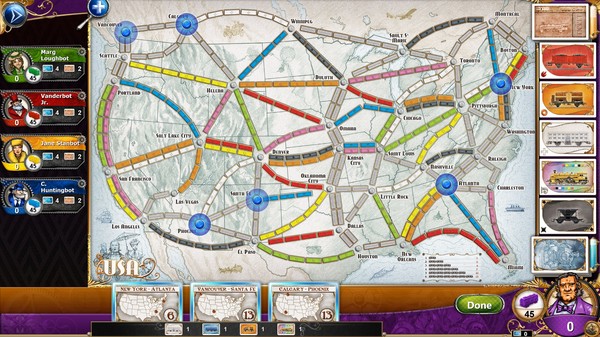
By the time he graduated from university there was one thing he wanted to do above all else: design a best-selling board game.īut while his designs were well-received by niche “hobbyist” gamers, none sold well enough to provide him with a steady income. But unlike many of his peers, he never stopped playing. “I was working as a waiter to give myself some flexibility, but in truth I was working too many hours and I had less and less time to devote to design.”Ī lifelong gamer, some of Moon’s most enduring childhood memories are of family Risk and Monopoly sessions.

“I wasn’t making much money at it, that’s for sure”, Moon said. The financial hardship was taking its toll. He had spent two decades in a succession of low-paid jobs, working on game designs in his spare time. In 2003 its designer, Alan R Moon was on the verge of giving up. In an industry where a game with sales in the five figures can be considered a hit, Ticket to Ride has sold over three million copies and generated retail sales of more than $150m (£93.3m).įor all its success, though, the game came close to never being published. It’s a thoughtful and understated example of game design – and in the 10 years since Ticket to Ride was first published it’s proven extremely popular. Should you claim routes that work to your advantage, or ones which block off options for your opponents? Should you take the most direct route between your objective cities, or a more roundabout path to avoid giving away your plans? Sales of $150m It asks players to make constant tactical decisions. This makes Ticket to Ride a game of strategy, subtlety and opportunism. Fail, and you’ll take a penalty that could drop you from first to last place. Link those cities up by the end of the game and you’ll receive bonus points. Each player also receives cards listing pairs of cities. Most turns see players taking one of two actions – adding cards to their hand or playing cards to claim routes between cities on the board. Played on a lavishly illustrated map of the United States and Canada, the game is deceptively simple. Released in 2004, it casts players as travellers crossing North America in the age of steam.

It's really easy to understand, it's super fast-paced because you can only do one thing on your turn (draw new cards or claim a route), and it still gives the brain a nice workout if you like to play tactically.One of the most successful productions of this board game renaissance is Ticket to Ride. It takes time to collect the cards in the right colour, and there are a finite number of routes, which means you need to make sure that someone doesn't claim a nice direct route between two cities that you need, otherwise you'll be taking the long way around. To claim a route, you need to have some coloured Locomotive card in your hands that match the colour of the route you want to claim, and then you can lay down some of your stock of train cars on it. You can actually pick up more Destination cards during the game, adding a risk/reward element. If you achieve it, you get the points on the card if you don't, you lose the points on the card.

At the start of the game, you'll receive Destination cards telling you two cities, and challenging you with connecting those two via a continuous route that you own.

In the basic version of Ticket to Ride, you'll all aim to become the owner of railway routes between different cities across a board.


 0 kommentar(er)
0 kommentar(er)
